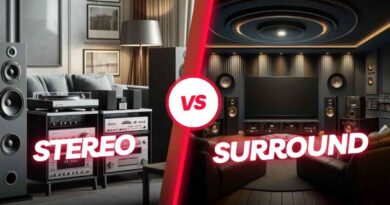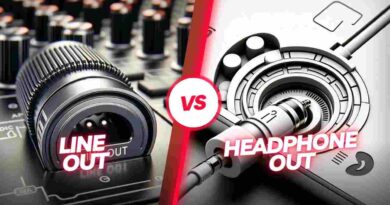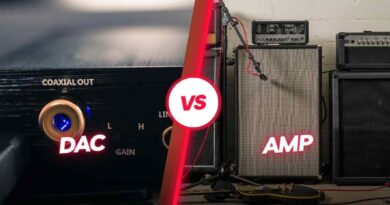Enclosed Vs. Free Air Subwoofer: Which Is Better?
Bass. It’s the pulse of your music, the rumble that sends chills down your spine during a movie explosion. But achieving that perfect low-end satisfaction can be tricky. When it comes to subwoofers, two main options emerge: enclosed and free air.
Here’s the dilemma: Enclosed subwoofers promise deeper, more impactful bass, but they require building or buying a dedicated box. Free air subs seem like a space-saving dream, but will they leave your bass feeling boomy and undefined?
This guide will break down the pros and cons of each approach, helping you decide which subwoofer setup delivers the low-end magic you crave.
What is an Enclosed Subwoofer?
Definition and Basic Design
An enclosed subwoofer, as the name suggests, is a type of subwoofer that is contained within an enclosure or a box. This design is prevalent in both home audio systems and automotive sound systems. The enclosure is specifically designed to match the subwoofer’s specifications to optimize the audio output.
Benefits of Enclosed Subwoofers
Controlled Audio Output: The enclosure limits the movement of the subwoofer’s back wave, allowing for more precise sound reproduction.
Versatile Design Options: Enclosures can be tailored for specific types of bass sounds, like deep bass or fast bass, suitable for different music genres.
Drawbacks of Enclosed Subwoofers
Size and Space: Enclosed subwoofers typically require more space, which can be a limitation in smaller areas.
Cost: The additional materials and design efforts can make enclosed subwoofers more expensive than free air subwoofers.
What is a Free Air Subwoofer?
Definition and Basic Design
A free air subwoofer does not use a traditional enclosure. Instead, it relies on the existing space within an environment, such as a car trunk or the rear deck, to serve as its enclosure. This type of subwoofer is mounted so that it uses the air inside the vehicle to produce sound.
Benefits of Free Air Subwoofers
Space Efficiency: Free air subwoofers are ideal for limited spaces as they do not require additional enclosures.
Cost-Effectiveness: Less material and manufacturing effort make these subwoofers generally cheaper.
Drawbacks of Free Air Subwoofers
Sound Quality: Without a dedicated enclosure, controlling the back wave is more challenging, potentially leading to less precise bass response.
Installation Constraints: Proper installation is crucial, and incorrect installation can lead to poor sound quality or damage to the subwoofer.
Comparing Performance: Enclosed vs. Free Air Subwoofers
Sound Quality Comparison
When comparing sound quality, enclosed subwoofers generally provide a more accurate and richer bass experience due to their design that manages sound waves effectively. The enclosed space helps in creating a consistent audio output, which is crucial for high-fidelity sound reproduction.
Installation and Flexibility
Free air subwoofers score higher in terms of installation flexibility. They can be integrated into existing spaces without the need for significant modifications. This makes them particularly appealing for applications where space is at a premium.
Cost Implications
Enclosed subwoofers, with their need for additional components like the enclosure itself and potentially more complex installation, often come at a higher cost. Free air subwoofers, being less complex, are usually more affordable.
Key Takeaways:
- Enclosed subwoofers are superior in sound quality.
- Free air subwoofers offer greater installation flexibility and are more budget-friendly.
Durability and Longevity: Enclosed vs. Free Air Subwoofers
Durability Factors
Enclosed subwoofers are typically more durable due to their protective enclosures, which shield the components from physical damage and environmental factors. The robust design ensures that the subwoofer operates efficiently over a longer period.
Longevity Considerations
Free air subwoofers, while convenient, may suffer from faster wear and tear if not installed correctly. The lack of an enclosure exposes the subwoofer to more environmental variables that can degrade its components quicker than in an enclosed setup.
Optimal Usage Scenarios: Enclosed vs. Free Air Subwoofers
Best Uses for Enclosed Subwoofers
Enclosed subwoofers are ideal for both home theaters and car audio systems where space is not a constraint. They excel in environments where sound quality and bass precision are prioritized.
Best Uses for Free Air Subwoofers
Free air subwoofers are best suited for automotive applications where space saving is crucial. They are also a good choice for users looking for a more straightforward installation process and a less expensive option.
Power Handling and Efficiency: Enclosed vs. Free Air Subwoofers
Power Handling Capabilities
Enclosed subwoofers are designed to handle more power compared to free air subwoofers. The enclosure provides a controlled environment that allows the subwoofer to utilize its power capacity efficiently, leading to better performance and louder sound output.
Efficiency Comparison
Free air subwoofers, lacking an enclosure, may not use the power they receive as efficiently. This can result in lower sound output per watt of power, making them less efficient than enclosed subwoofers.
Key Takeaways:
- Enclosed subwoofers handle power more effectively.
- Free air subwoofers may be less efficient in their power usage.
Impact on Audio Quality: Enclosed vs. Free Air Subwoofers
Audio Precision
The precise audio control offered by enclosed subwoofers is unmatched. The tailored enclosure allows for detailed sound tuning, which is vital for audiophiles and those who value accuracy in sound reproduction.
Bass Response
While free air subwoofers can produce significant bass, the quality and precision of the bass can vary greatly depending on the installation. Enclosed subwoofers generally provide a more consistent and powerful bass response.
Ease of Installation: Enclosed vs. Free Air Subwoofers
Installation Complexity
Installing an enclosed subwoofer can be more complex due to the need to accommodate the enclosure in the designated space. It often requires more planning and effort to ensure that the subwoofer fits correctly and performs optimally.
Installation Versatility
Free air subwoofers are generally easier to install, especially in vehicles, because they can be mounted using existing spaces without the need for a bulky enclosure. This ease of installation is a significant advantage for those who prefer a straightforward setup.
Key Takeaways:
- Enclosed subwoofers require more effort to install.
- Free air subwoofers offer greater ease and versatility in installation.
Maintenance Requirements: Enclosed vs. Free Air Subwoofers
Maintenance Ease
Enclosed subwoofers are usually more demanding in terms of maintenance. The enclosure itself may need regular checks to ensure it remains sound and does not compromise the subwoofer’s performance.
Low Maintenance Needs
Free air subwoofers typically require less maintenance since there’s no enclosure to worry about. However, ensuring that the mounting is secure and checking for any potential damage from environmental exposure remains important.
Frequency Response and Range
Frequency Range Capabilities
Enclosed subwoofers can be designed to enhance specific frequency ranges, offering a tailored audio experience that can be fine-tuned to the listener’s preference. This allows for superior control over how music and sound effects are reproduced.
Consistency in Frequency Response
Free air subwoofers, on the other hand, may struggle with consistency in frequency response due to the lack of a controlled environment provided by an enclosure. This can result in less predictable audio performance, especially in complex audio tracks.
Conclusion
Deciding between an enclosed and free air subwoofer largely depends on your specific needs and constraints. If you prioritize sound quality, precision, and are willing to accommodate the space and cost, an enclosed subwoofer is undoubtedly the better choice. It provides a superior audio experience with the ability to tailor sound to exact preferences.
However, if space and budget are your primary concerns, and you need a straightforward installation with decent performance, a free air subwoofer will serve you well. It offers a practical solution without the complexities of an enclosure, though with some compromises in sound quality. Ultimately, the choice between these two types of subwoofers should be guided by your particular audio needs, the physical space available, and your budget.
Frequently Asked Questions
Which subwoofer type is better for small cars?
Free air subwoofers are better for small cars due to their space-saving design.
Can enclosed subwoofers be custom-made?
Yes, enclosed subwoofers can be custom-made to fit specific spaces and sound preferences.
Are free air subwoofers good for home theaters?
Generally, free air subwoofers are not recommended for home theaters due to their less precise sound quality.
Do enclosed subwoofers use more power than free air subwoofers?
Yes, enclosed subwoofers typically use more power but also deliver better performance.
Can I install a free air subwoofer myself?
Yes, free air subwoofers can be installed by yourself if you follow the manufacturer’s guidelines.
Which type of subwoofer is more durable?
Enclosed subwoofers are more durable due to their protective enclosures.
Do free air subwoofers require special maintenance?
Free air subwoofers require less maintenance, but it’s important to check their mounting periodically.
Which subwoofer type is better for diverse music genres?
Enclosed subwoofers are better for diverse music genres as they provide superior sound customization.
Are free air subwoofers cheaper than enclosed subwoofers?
Yes, free air subwoofers are generally cheaper as they require fewer materials and labor.




